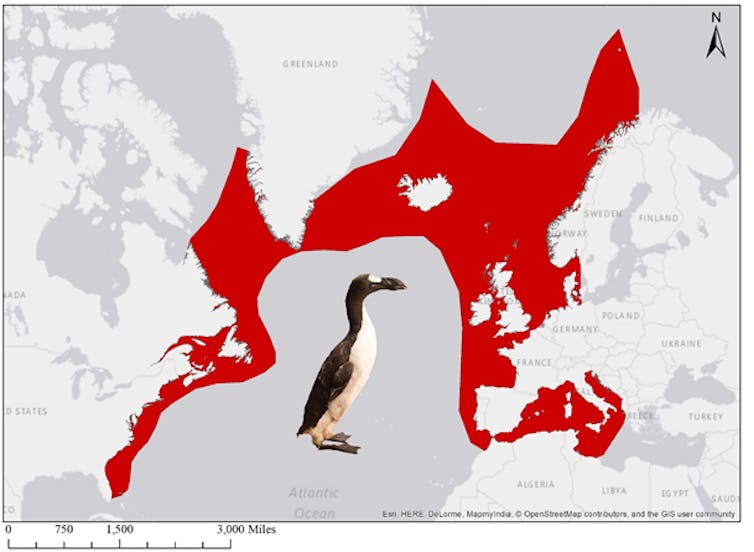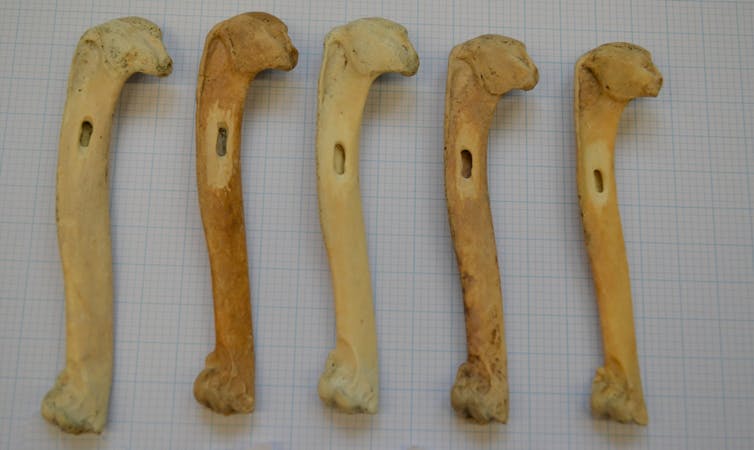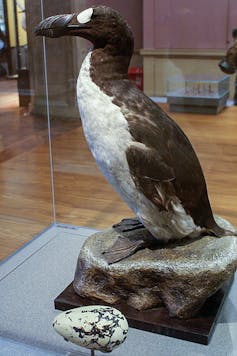
The North Atlantic was once home to a bird that bore a remarkable similarity to penguins. The great auk, also known as “the original penguin”, was a large, flightless, black and white bird, that is said to have existed in the millions. Despite its appearance, the great auk is actually a relative of razorbills and puffins, not of penguins. However, since around 1844, the northern hemisphere has been without its version of the penguin and it looks like we are to blame.
The great auk had long provided humans with a source of meat and eggs. But from around 1500, hunting dramatically intensified when Europeans discovered the rich fishing grounds of Newfoundland. Within 350 years, the last great auks ever reliably seen were killed to be put in a museum, and the species was lost forever.
Given the relative speed of this extinction, it’s worth asking whether other factors such as environmental changes were involved. Was the great auk heading for extinction before intensive hunting began? Or could it have survived and still be around today if it hadn’t been for humans?

In our recent study, my colleagues and I found no evidence that the great auk was already in decline or at risk of extinction prior to the intensive hunting. This suggests that no other factors were at play in their demise and human hunting pressure alone was enough to cause their extinction.
Our findings highlight how industrial-scale commercial exploitation of natural resources has the potential to drive even an abundant, wide-ranging, highly mobile species to extinction within a short period of time.
Ancient DNA
Through studying species that have become extinct we are able to learn things which can help us in the fight to conserve species still living today. One way to do this is to look at the genetics of extinct species. Using ancient DNA (aDNA) we can look at things like genetic diversity (how much genes varied between different individuals in a species), which can reveal trends in how genetically healthy the species is. It can also show us how a species may have responded to environmental change, hunting or the introduction of new species into its habitat.
There is lots of evidence, including archaeological records and written accounts, that shows the great auk was hunted throughout its existence. But until now we haven’t known what impact environmental change may have had on the bird’s extinction. If the species had been at risk of extinction prior to the onset of intensive hunting in the 16th century, we would expect to see signs in its DNA.

For example, if a species has low genetic diversity and most individuals are very similar, then the species is less likely to have certain individuals that can survive an environmental change when others can’t. So the species as a whole will be less able to adapt to that change.
Meanwhile, big differences in the DNA of individuals from different locations can also indicate that a species was divided into isolated populations that didn’t migrate or mix their DNA with other groups. This is known as population structure and can lead to less genetic diversity, increased inbreeding and an accumulation of “bad” genes, making it an important factor in a species’ vulnerability to extinction.
These kind of changes in genetic diversity are among the signatures we look for when studying species extinction. If we can’t find a loss in diversity during the last few centuries before extinction then it suggests the population declined rapidly, something which would indicate humans as the culprit.
We can also use statistical models called population viability analyses that look at the probability of a species going extinct in a given time. These models can be used to show if a realistic amount of hunting could be the sole cause of an extinction.

To find out which of these scenarios applied in the case of the great auk, we sequenced part of the bird’s DNA known as its mitochondrial genome. This involved taking samples from bones found by archaeologists and mounted skins and organs stored in museums around the world. We successfully generated DNA sequences from 41 individuals, which represented birds from across the major areas of where the auk lived, spanning a period from around 15,000 years ago to around 170 years ago.
No gradual decline
We found that genetic diversity was high across the samples, with evidence for a constant population size and no evidence of a population decline or of pronounced population structure. This suggests the great auk was not at risk of extinction before intensive human hunting and that its extinction followed a population decline too rapid to show up in our data. Meanwhile, the population viability analysis revealed that hunting alone could have been enough to cause the extinction of the great auk.
Today, seabirds are more threatened than any comparable groups of birds, with a third of species at risk of extinction and half facing decline. Threats to seabirds include climate change, habitat loss, pollution, human fishing and the direct exploitation from harvesting eggs, chicks and adult birds for food and trophy hunting. Seabirds play a globally important role in ecosystems, acting as predators, scavengers, nutrient subsidisers and ecosystem engineers, so understanding more about why they are going extinct is very important.
Our research builds the case for human hunting as the main cause of the great auk’s extinction, as well as reminding us how real the threat to today’s seabirds is. The findings also show why we need to thoroughly monitor commercially harvested species, particularly in poorly researched environments such as our oceans. This will help us better understand what is happening to the world’s threatened species and hopefully act before they follow the great auk into history.
Jessica Emma Thomas received funding from NERC PhD Studentship (NE/L501694/1), the Genetics Society-Heredity Fieldwork Grant, and European Society for Evolutionary Biology–Godfrey Hewitt Mobility Award.
This article was originally published on The Conversation. Read the original article.







